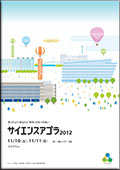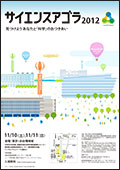About Science Agora
History
Science has now become inseparable closely related with our daily lives. The fact that many scientific
issues affect our whole of society, requires the participation and engagement of diverse stakeholders—
and the public—besides expert groups in the scientific community. Thus, to ensure a better tomorrow of
ours, we should take one more step forward: to be willing to be more informed of, and to think together
about, what science brings us and the relationship between science and ourselves.
Science communication has been a key concept in the evolving links between science and society. People
who are involved in this function, known as science communicators, might be teachers at schools who
impart knowledge to students, as well as mediators or interpreters who involve people in finding out
the values and meanings of specific scientific outcomes, sometimes giving feedback to scientists and
policymakers who drive research activities.
Since its inception in 2006, Science Agora has been offering a place for such science communication activities, the number of its
participants being increasing every year. The most recent Science Agora 2012 invited 212 programs offered by 191 organizing
parties, and had roughly 2,250 exhibitors served for more than 4,000 visitors during the 2-day event. Science Agora welcomes
unique proposals from any geographic areas; in reality, some very ambitious ones inspire other exhibitors and presenters to
apply practices in their own context. In this way, Science Agora functions as a hub to evolve the network, and create expand the
definition of science communicators.
Political Background
Science Agora is built upon on Japan's Science and Technology Basic Plan. The Third Plan (effective in FY2006-2010)
includes a chapter entitled "Science and Technology to Be Supported by Society and the Public," in which promotion of science
communication is described using expressions such as "Improving the Public Awareness of Science and Technology." The
subsequent Fourth Plan (FY2011-2015) makes a further step forward in this effort; namely, to encourage involvement and
collaboration with the public in national science and technology policy-making. Science Agora is positioned as a core place for the
practice of science communication, as well as for discussions and dialogues among members of our society more broadly.
Science Agora has continued to be as open and multifaceted as possible. There are virtually no eligibility requirements for
submitting proposals. Financial barriers are designed to be minimal for both exhibitors (no exhibitor fees) and participants
(admission is free). Instead, it asks all the exhibitors to be communicative, and to make their presentation accessible to a wider
audience. Thus, throughout the past seven events as well as the upcoming ones, it hosts not only large institutions, agencies,
companies and academic societies but also individual researchers, educators, students, museum staff, freelancers, artists,
comedians, and all kinds of volunteers.
 Under the theme “Finding a good relationship between people and science,” Science Agora 2012 focused on communication.
This was aimed at thinking and discussing together about how to establish a better relationship between science and each
individual of us in order to construct a better society after the experience of the Great East Japan Earthquake and the nuclear
power plant accident. As a significant outcome of this year, Science Agora succeeded in focusing on science communication not
only from the perspective of introducing the pleasures and wonders of science, but also from various other viewpoints.
Under the theme “Finding a good relationship between people and science,” Science Agora 2012 focused on communication.
This was aimed at thinking and discussing together about how to establish a better relationship between science and each
individual of us in order to construct a better society after the experience of the Great East Japan Earthquake and the nuclear
power plant accident. As a significant outcome of this year, Science Agora succeeded in focusing on science communication not
only from the perspective of introducing the pleasures and wonders of science, but also from various other viewpoints.
| # | Year | Theme & Major Aim |
|---|---|---|
| 1 | 2006 | Creating a place of assembly where science and society are
intertwined (Networking science communicators) |
| 2 | 2007 | Connect, and turn on the lights of future! (Broadening the field) |
| 3 | 2008 | Message from Japan for our future on Earth (Increasing diversity) |
| 4 | 2009 | Message from Japan for our future on Earth II (Sending out
messages) |
| 5 | 2010 | A place where we think about science and our future (Expanding
to new sectors) |
| 6 | 2011 | Planting the seeds of science for restoration from Japan
earthquake |
| 7 | 2012 | Finding a good relationship between people and science |
Event Statistics
Science Agora enjoys steady growth. It has been contributing to expansion of networks among practitioners of excellence nationwide, and thus offers a myriad of communication opportunities for everyone at all ages.
| # | Year | Date | Place | Attendance | # Programs | # Parties |
|---|---|---|---|---|---|---|
| 1 | 2006 | Sat-Mon, Nov. 25-27 | Tokyo | 1700 (estimated) | 100 | 83 |
| 2 | 2007 | Fri-Sun, Nov. 23-25 | Tokyo | 2959 | 94 | 124 |
| 3 | 2008 | Sat-Mon, Nov. 22-24 | Tokyo | 6109 | 123 | 138 |
| 4 | 2009 | Sat-Tue, Oct. 31-Nov. 3 | Tokyo | 8705 | 147 | 141 |
| 5 | 2010 | Fri-Sun, Nov. 19-21 | Tokyo | 5934 | 145 | 146 |
| 6 | 2011 | Fri-Sun, Nov. 18-20 | Tokyo | 7057 | 194 | 183 |
| 7 | 2012 | Sat-Sun, Nov. 10-11 | Tokyo | 6255 | 212 | 191 |
 |
 |
 Science Agora continues to reach out to science communicators in a broader sense,
including sometimes those beyond conventional scientific communities. Exhibitors are
expected to interact and learn on site so that the event induces improvement in their
science communication skills, thereby helping deliver their experience to local activities.
Science Agora continues to reach out to science communicators in a broader sense,
including sometimes those beyond conventional scientific communities. Exhibitors are
expected to interact and learn on site so that the event induces improvement in their
science communication skills, thereby helping deliver their experience to local activities.Miraikan, or the National Museum of Emerging Science and Innovation, has served as one of the main venues of Science Agora since 2006. With its neighboring institutions and surroundings, the event offered an open, festival-style atmosphere for its visitors each time.
2012 Facts
| Who exhibited? ◎ A broad spectrum of sectors joined together. |
Who visited? ◎ Both children and adults enjoyed the visit. |
 |
Age |
 |
|
| Gender |
|
| ◎ The event showcased nationwide activities. |
 |
 |
Occupation |
 |
|
 |
|
| Almost half (49%) of exhibitors answered that they undertake activities outside of the greater Tokyo Area. | |
| Visit our website for additional data, program archives (including audiovisual recordings), hundreds of links, and other resources! >> http://www.jst.go.jp/sis/scienceagora/ | |




